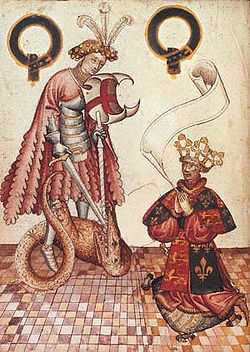William Bruges

William Bruges (c. 1375 – 9 March 1450) was an English officer of arms. He is best remembered as the first person appointed to the post of Garter King of Arms, which is currently the highest heraldic office in England.
Origins
William Bruges was the son of Richard Bruges, Lancaster King of Arms, and his wife Katherine. The younger Bruges was appointed Chester Herald on 7 June 1398. He was later attached to the household of Henry of Monmouth, then Prince of Wales, Earl of Chester, and Duke of Aquitaine.
It is believed that Bruges was promoted to Guyenne King of Arms on the accession of Henry V and was sent to France in that capacity in early 1414. In February 1416, as Aquitaine King of Arms, Bruges was sent to emperor-elect, Sigismund, on royal business. At this time, the titles of Aquitaine and Guyenne were interchangeable.
Garter King of Arms
The position of King of Arms of the Order of the Garter, usually known as Garter King of Arms, was created sometime around 1415, and Bruges appointed to it. His father's will, dated July 1415, refers to William Bruges as both Guyenne and Garter King of Arms. After this, the next mention of Bruges in the position is 13 September 1417. It was the first time a king of arms had been specifically appointed for the service of an order of chivalry. By virtue of this office, he held permanent authority over the provincial kings of arms.
%2C_f.8_-_BL_Stowe_MS_594_(cropped).jpg)
Bruges's appointment as the first Garter King of Arms coincided with a series of moves to regulate heraldic matters. In June 1417 the king clamped down on the unauthorized wearing of coat armour. In September the duke of Clarence ruled on matters of precedence between the heralds and the serjeants-at-arms. In January 1421 the English heralds held their first chapter and directed that a common seal for that office be made. Resolutions were to govern the office of arms and its members, with chapters summoned by Garter. In the same year, as part of Henry's revival of the Order of the Garter, some statutes of the order were revised and at about the same time many heraldic stall plates of former companions were set up in St. George's Chapel, Windsor. Bruges was also responsible for producing his Bruges Garter Book around 1430, which is the earliest known armorial of the order.
In 1421 Bruges took part in the coronation of Queen Catherine, and in the following year he officiated at Henry V's funeral. Under Henry VI there was scarcely a year in which he was not sent on at least one mission, sometimes staying abroad for many months. He was usually concerned with France, but he also visited Normandy and Brittany, Flanders, Hainault and Holland, Scotland, Spain, Portugal, and Italy.
Bruges died on 9 March 1450 on his sizeable estate in Kentish Town. He was buried in St George's Church, Stamford. He had married, before 1415, Agnes Haddon, and they had three daughters, one of whom, Katherine, married John Smert, Bruges' successor as Garter.
See also
External links
Sources
- Mark Noble, A History of the College of Arms. (London, 1805).
- Walter H Godfrey and Sir Anthony Wagner, The College of Arms, Queen Victoria Street: being the sixteenth and final monograph of the London Survey Committee. (London, 1963).
- Hugh Stanford London, The life of William Bruges, The First Garter King of Arms. Harleian Society. (London, 1970), 111–12.
- Sir Anthony Wagner. Heralds of England: a History of the Office and College of Arms. (London, 1967).
- Sir Anthony Wagner. A Catalogue of English Mediaeval Rolls of Arms. Harleian Society (London, 1950), 100.
- P. J. Begent. The Creation of the Office of Garter King of Arms. Coat of Arms, New Series Vol 11 No 172 (1995), 134–40.
| Heraldic offices | ||
|---|---|---|
| New title | Garter King of Arms 1415–1450 |
Succeeded by John Smert |